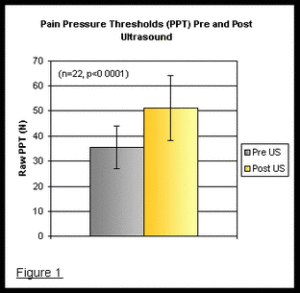
Clinical Test Result
Ultrasound Reduces Myofascial Trigger Point Sensitivity
Dr. John Z. Srbely, B.Sc., D. Ac., D.C., Ph.D. , and
Dr. Matthew J. Weisbrod B.Sc., MD, C.C.F.P. (c),
Canadian Institute of Spinal Health
PURPOSE:
Myofascial trigger points (TrP) are discrete palpable hyperirritable loci within taut bands of skeletal muscle; pressure application elicits a referral sensation/paresthesiae (1). There is growing body of evidence suggesting that a substantial proportion of common adult musculoskeletal pain syndromes are manifestations of myofascial trigger point activity (2). Ultrasound (US) represents a potentially cost-effective, non-invasive approach to management of soft tissue pain syndromes in the clinical setting. This study specifically explored the biophysical effects of ultrasound on trigger point pain sensitivity.
METHODS:
This pilot study investigated the effect of ultrasound on the Pain Pressure Threshold (PPT) of a single, discrete trigger point region in the trapezius muscle. Subjects (n=22) were randomly selected from the pool of subjects within a rehabilitation facility and examined for trigger points. Trigger points were detected via manual palpation and a baseline PPT value was recorded. Five minutes of ultrasound (continuous pulse, 1.0 W/cm2, 1 MHz) was applied to the trigger point after which a follow-up PPT reading was taken. No other intervention was given.
RESULTS
Figure 1 summarizes the effect of ultrasound intervention on the raw PPT scores recorded from the trapezius trigger point. The mean raw PPT value of the pre-US group (baseline) was 35.4 N (± 8.5). Comparatively, the mean post-US score was 51.1 N (±12.8), representing a 45% decrease in pain sensitivity at the trigger point locus.
CONCLUSION:
Many studies have demonstrated the beneficial effects of ultrasound therapy in tissue healing, both biochemically and biomechanically (4). US has also been shown to accelerate the rate of soft tissue and fracture healing (5). This pilot study provides early evidence that US may also play an important therapeutic role in pain modulation.
REFERENCES:
Simons DG. Myofascial origins of low back pain. 1. Principles of diagnosis and treatment. Postgrad Med 1983; 73(2):66, 68-70, 73.
Simons DG. Journal of Electromyography and Kinesiology, 2004;14;1;95-107
Boal RW. Journal of Manipulative and Physiological Therapeutics, 2004;27:314-326
Demir H. Comparison of the Effects of Laser, Ultrasound and Combined Laser and Ultrasound Treatments in Experimental Tendon Healing. Lasers in Surgery and Medicine 35:84-89 (2004)
Dalecki D. Annu. Rev. Biomed. Eng. 2004. 6:229-48.

